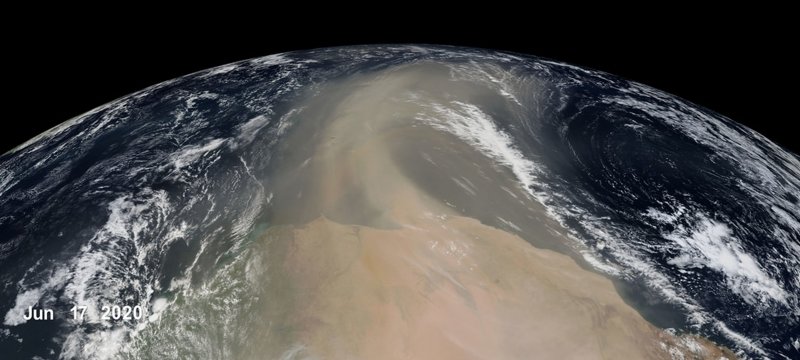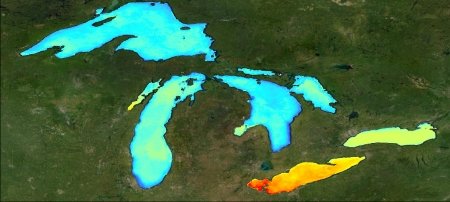A new global weather station-based dataset developed at Michigan Technological University enables long-term, large-scale monitoring of the dust cycle.
As wind shapes the surface of the Earth, it pulls dust from dry, exposed land surfaces into the atmosphere. Xin Xi, an assistant professor in the Department of Geological and Mining Engineering and Sciences at Michigan Tech, uses observations and models to study the sources, transformation and transport of dust to assess its impact on climate and air quality.
“Airborne dust aerosols impact the Earth in a myriad of ways,” he explained. “Mineral dust interacts with the global energy budget, ocean biogeochemistry, air quality and agriculture.”
Dust aerosol is not all bad, noted Xi. “Dust outflow from continental sources is considered a primary source of mineral micronutrients for the open ocean, where biological productivity is limited by the availability of iron.”
On the other hand, he added, dust deposited on the surface of snow can decrease its ability to reflect sunlight, impacting Earth’s surface energy balance and hydrology. And there are impacts on human health. “For human settlements located downwind, dust aerosol is a major safety and health hazard, with elevated concentrations of particulate matter and dust-borne pathogens,” said Xi.
About the Researcher

Xin Xi
- xinxi@mtu.edu
906-487-2029
Research Interests
- Process-based modeling of the sources, transformation, transport, and sinks of atmospheric particulate matter and gases, and their impact on climate and air quality
- Interactions between changes in land-cover/land-use and atmospheric compositions
- Remote sensing science and applications in environmental mapping, modeling, and monitoring
- Synergy between physically-based modeling and machine learning in climate and air quality research
How much dust is there? According to scientific estimates, global annual dust emissions can range from 1 to 5 billion tons, shifting each year according to climate. “Climate controls the supply of erodible materials, the erosive force of surface winds and the transport route and residence time of dust particles in the air,” said Xi.
“The dust cycle is highly sensitive to climate,” he added. “Understanding dust variability and its response to climate is key to reducing the uncertainty of future climate projections. To do that, we need more fundamental knowledge to quantify the multifaceted impact of dust. That includes dust source locations and properties, dust variability and trends at different timescales — and all the governing factors and processes.”
Satellite remote sensing, a major source of information to study global dust variability, lacked the specifics Xi needed. “Spaceborne sensors offer an unprecedented view of large-scale aerosol transport events on a daily basis,” he said. “But they generally have a low sampling frequency, usually once per day. They also lack the data record length required to study variability over multiple decades in response to long-term climate change.”
Xi decided to revisit the National Oceanic and Atmospheric Administration’s Integrated Surface Database. “Before satellite remote sensing became available, surface weather observations — specifically the dust weather visual report and horizontal visibility — were a primary source of information for monitoring wind erosion and dust activity around the world,” he said.
"I believe the visibility record has not yet been used to its full potential, so I took on the effort to develop a homogenized dust-climate record."
Using NOAA ISD records, Xi set out to create a new dataset for evaluating global dust, which he named duISD. Xi homogenized the NOAA records to remove nonclimatic factors, and plans to perform data fusion, combining multiple sources of information into consistent spatial and temporal scales. “The dust-climate connection exists on multiple temporal scales, from seasonal to interannual, multidecadal or even glacial-interglacial scales,” he explained.
Xi used the dataset to characterize dust variability and climate connections around the world. The results of his study are featured in an article in the Journal of Geophysical Research: Atmospheres.
His hard work revealed contrasting behaviors at regional dust sources in response to recent decades’ climate drivers:
- North Africa experienced increased dust activity in the last decade (2010-19), due to reduced soil moisture and enhanced wind speed following the transition of the North Atlantic Oscillation from strong negative to recurring positive phases in 2011.
- Dust production has declined significantly in the Middle East since 2015, following the amelioration of a decade-long drought in the Tigris-Euphrates basin as the climate shifts to more El Niño-like conditions and positive and weak negative Pacific Decadal Oscillation phases.
- East Asian dust variability is primarily driven by wind, which explains the negative trend from 1986 to 1997 and the absence of significant trends during the past two decades.
Xi’s open-source dataset, duISD, can be accessed online.
Michigan Technological University is an R1 public research university founded in 1885 in Houghton, and is home to nearly 7,500 students from more than 60 countries around the world. Consistently ranked among the best universities in the country for return on investment, Michigan's flagship technological university offers more than 120 undergraduate and graduate degree programs in science and technology, engineering, computing, forestry, business, health professions, humanities, mathematics, social sciences, and the arts. The rural campus is situated just miles from Lake Superior in Michigan's Upper Peninsula, offering year-round opportunities for outdoor adventure.






Comments